Our unique decision making model captures created knowledge that can be reused
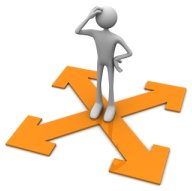 When describing our decision making model, it is necessary to clarify that we are not talking about a specific decision making technique. Our model supports multiple techniques and underlies our
decision making process.
When describing our decision making model, it is necessary to clarify that we are not talking about a specific decision making technique. Our model supports multiple techniques and underlies our
decision making process.
The model is captured in two levels and has five fundamental purposes. At the highest level, we capture the "Decision Network" (right side of graphic below) and at the next level we capture all the information associated with a specific decision (a portion of which is shown on the left side of the graphic below).
The purpose of this two level model is:
- To describe the Problem to be Solved or the Opportunity that's at hand. This defines the scope of the current decision.
- To identify and then select one or more solutions that solve the problem and/or make the opportunity a reality.
- To create "knowledge containers" that capture information for each specific decision, and the information is represented in a way that allows future reuse.
- To interconnect decisions so that you can understand how the context of each decision constrains other related decisions (see the right graphic below).
- To capture and visualize how decisions change over time.

Our model of decision making characterizes a decision as a way to convert people's needs and desires into preferred outcomes. It contains three parts that serve the ultimate goal of creating the best possible decision outcome. These include:
- The Opportunity/Problem definition
- The Potential Solution/Alternative identification
- The analysis and rationale surrounding the final selection
Focusing on your Needs - Two Levels of the Model
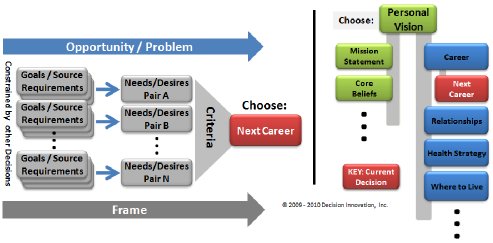
The model above (on left side of graphic) indicates that the goals (source requirements) that will drive this specific "Choose Next Career" decision come from other higher level related decisions (Personal Vision, Mission Statement, Core Beliefs, ...). These goals (source requirements) are mapped to specific needs/desires (musts/wants), turning them into objective criteria that will ultimately be used to pick from the possible solutions (alternatives).
Exercise your Creativity on the "Potential Solutions" Side of the Model
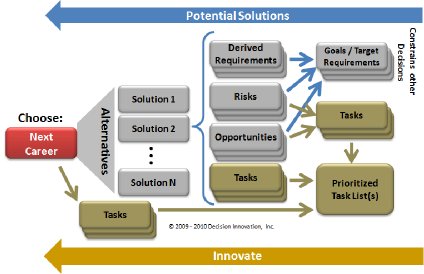
Once the current decision has a clear "Problem/Opportunity" definition as defined above, the right side of the decision model can now be exposed. It is important that multiple alternatives be considered (Alt 1, Alt 2, ...). Potential solutions (alternatives) should be adequately characterized to make it understandable and clear to all decision participants.
Once one or more preferred solutions are selected, there are additional pieces of information that must be captured. These include:
- Derived goals (requirements) are written at a high level and will later be decomposed into detailed goals (target requirements) which become the goals (source requirements) for other related decisions.
- Tasks related to implementing the preferred solutions (alternatives). Tasks are also created to manage the decision analysis itself.
For high value decisions, the model shows additional elements that may be explored before making the final choice. These include:
- Risks related to each solution (alternative). There are no totally risk free alternatives. The risks will vary by severity and their probability of occurrence. Risk mitigation can directly create new target requirements and tasks.
- Opportunities related to each solution (alternative). Opportunities are the positive side of risk. Opportunities vary by their strength and their probability of occurrence. Opportunity improvement can directly create new target requirements and tasks.
Information captured across the decision creates knowledge!
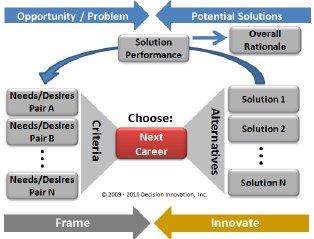
The decision analysis and alternative selection elements capture how each solution performs against each criterion (solution performance) and the overall rationale for the chosen solution. The flexibility of this model allows for the use of the best decision making technique for the type of decision being made.
Manage Change by Managing Decisions Over Time
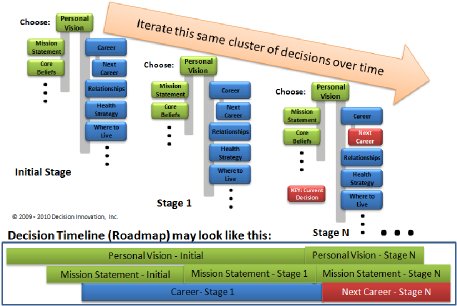
Time is a very powerful element of our decision making model. The graphic above shows how each decision will go through a series of states, and those states can be visualized as a decision timeline or roadmap. A powerful aspect of this concept is that the "Decision Network" model stays constant, while the choices within any one decision change over time. We can now manage change by managing decisions, since decisions are the true source of all change we can control.
Putting the Decision Making Model Together
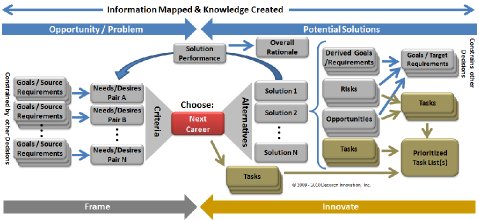
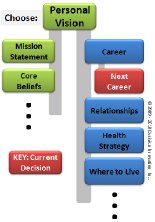 Now you can see the entire decision making model for a specific decision (above) within the overall decision network model (to the right). Goals (requirements) become the main connectors between decisions across the decision network model. Goals (Target requirements) from one decision become the goals (source requirements) of the connected decisions. With these connections, knowledge is created and can now flow between related decisions allowing change across the decision network model to be managed.
Now you can see the entire decision making model for a specific decision (above) within the overall decision network model (to the right). Goals (requirements) become the main connectors between decisions across the decision network model. Goals (Target requirements) from one decision become the goals (source requirements) of the connected decisions. With these connections, knowledge is created and can now flow between related decisions allowing change across the decision network model to be managed.
This decision making model provides a number of benefits
We use this model as the basis to provide decision making solutions across personal, business, and consumer decisions. Some of the benefits of building on this model include:
- Supports a consistent and simple decision making process (Frame, Innovate, Decide, and Manage)
- Enables use of all or parts of previous decisions
- Allows use of the most appropriate decision making technique
- Ensures capture of the important information needed to determine where a decision goes right or wrong
- Provides a framework for collaboration and communication
- Captures and allows easy access to and reuse of expert knowledge
- Makes decisions in the context of other related decisions
- Encourages better decision making through a consistent and repeatable framework
- Promotes more effective innovation through better characterization of needs and problems
Manage decisions, not Issues
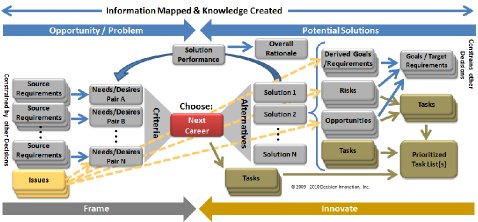
Issues are a constant in most people's lives. If they are not managed, they will become disruptive and defocusing. However, issue is an ambiguous term that is used to describe a problem, a requirement, a need, a criterion, a risk, an opportunity, or a defect. Our decision making model eliminates this confusion by forcing a distinction to be made so that the information is mapped to the appropriate decision element. Issues are not part of the explicit model, since they must be captured as a decision element.
Return from Decision Making Model to Decision Making Process

